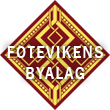Reconstructed rules: HNEFATAFL-TABLUT
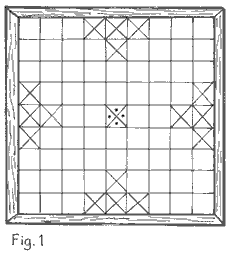 1. The game is for two people. One plays as the Swedes and has a King and 8 guards. The other plays as the Muscovites with 16 muscovites.
1. The game is for two people. One plays as the Swedes and has a King and 8 guards. The other plays as the Muscovites with 16 muscovites.
2. The game is played on a board with 9 x 9 squares (see fig 1). The centre square is specially marked and called the castle. On each side of the board on the edges there are 4 marked squares, forming a T-shaped camp. These squares are called camp squares.
 3. The pawns are placed as shown in fig 2. The king is placed in the castle square surrounded by his 8 guards, 2 on each side. The Muscovites start in the camp squares, 4 in each camp.
3. The pawns are placed as shown in fig 2. The king is placed in the castle square surrounded by his 8 guards, 2 on each side. The Muscovites start in the camp squares, 4 in each camp.
4. Players cast lots to decide who plays as the Swedes. The Swedes have the first move.
 5. All pawns are moved like the tower in chess, i.e. horizontally or vertically. You may not skip over pawns, nor move diagonally.
5. All pawns are moved like the tower in chess, i.e. horizontally or vertically. You may not skip over pawns, nor move diagonally.
6. A hostile pawn is defeated by placing two of your own pawns on both sides of it (see fig 3).
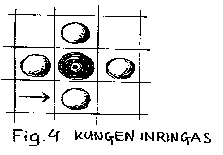 7. A defeated pawn is removed from the board. It is allowed to move a pawn in between two hostile pawns. If the opponent want to defeat the moved pawn he must move one of his own pawns away and then move it back, or move another pawn into its place.
7. A defeated pawn is removed from the board. It is allowed to move a pawn in between two hostile pawns. If the opponent want to defeat the moved pawn he must move one of his own pawns away and then move it back, or move another pawn into its place.
8. The king cannot be directly defeated, and has to be surrounded on all 4 sides. If the Muscovites succeed with this they have won the game (see fig 4).
9. The Swedes win the game if the King has a clear path off the board that the Muscovites cannot block. When the Swedish player spots such a way out, the opponent must be warned by saying "raichi". Otherwise you may not leave with your next move.
10. If the king has more than one exit path available at the same time he has a clear victory since the Muscovites cannot block more than one exit in their next move. The Swedish player informs the opponent of this by saying "tuichu".
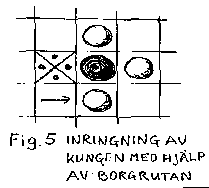
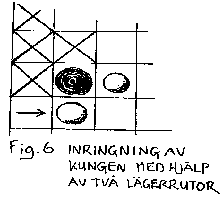
11. Special rules apply for the castle and camp squares. Only the king may stand in the castle. When the king has left the castle he may not return there. Neither he nor any other pawn may pass through the castle. The same thing applies to the camp squares: i.e. they are off limits for all pawns that are not already on them. Thus the king cannot make his escape through a Muscovite camp.
A muscovite standing in his camp can attack a guard. A muscovite standing on the protuding square of a camp can be defeated if two Swedish pawns are placed on both sides of it.
To the king the castle, once he has left it, and the enemy camp squares are considered hostile. Thus these squares can be used by the muscovites to surround him. If the king stands next to the castle only 3 muscovites are needed to surround him, and if he stands next to a camp with camp squares on two sites only two muscovites are needed (see fig 5 and 6).
12. A muscovite may move within their camp, and may pass other camp squares while leaving the camp. Once having left the camp he may not return there nor pass through a camp square.
13. In some situations a so called eternity move may occur. This applies to both exiting and surrounding. To break such a deadlock the offensive player must, after a few repeats, make a different move. This rule may be explained with the following example:
The king threatens to exit and a muscovite is moved to block the path. The king then moves to a new square and threatens to exit here as well. The same muscovite must be used to block the path this time as well. The king moves back to the first square and muscovite is also moved back to block. When these moves have been repeated a couple of times the Swede player must make a different move, since he is the offensive one.











